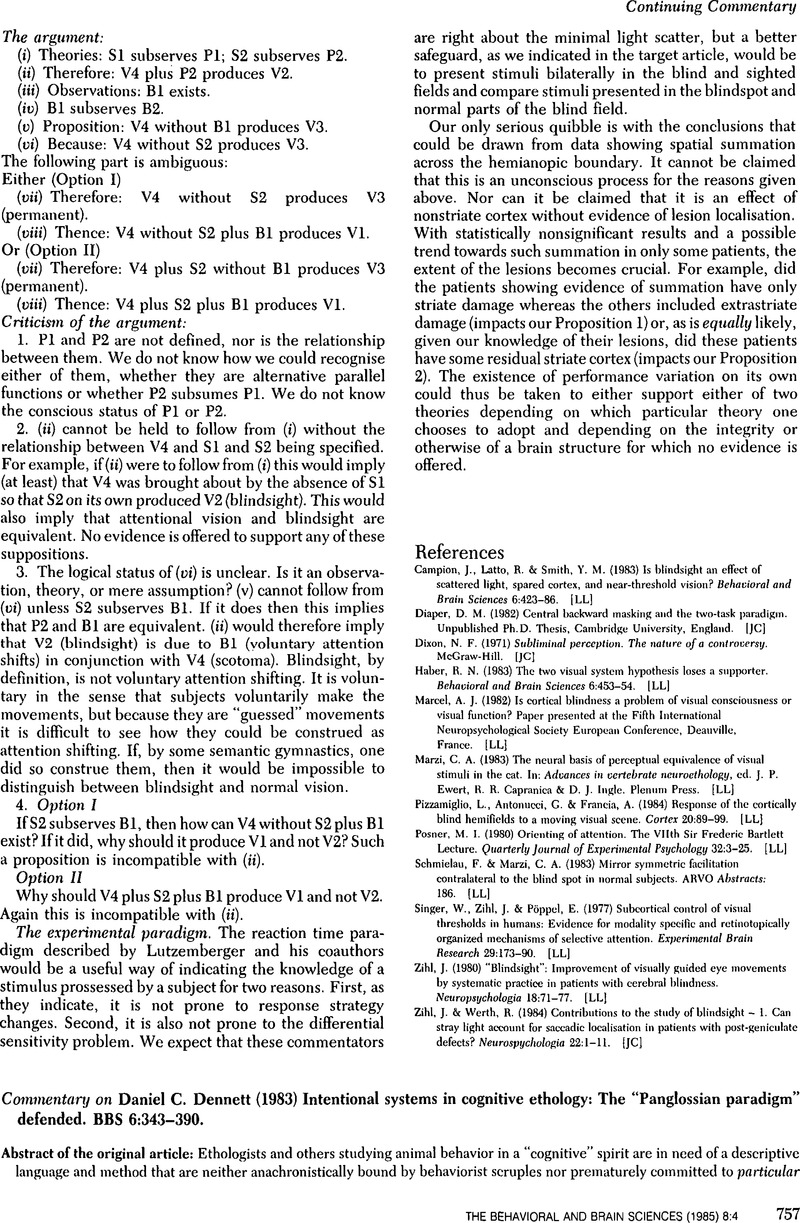Crossref Citations
This article has been cited by the following publications. This list is generated based on data provided by Crossref.
Smith, M. P.
1988.
Styles of computational representation.
Behavioral and Brain Sciences,
Vol. 11,
Issue. 03,
p.
530.
Dummett, Michael
1988.
Dennett on belief.
Behavioral and Brain Sciences,
Vol. 11,
Issue. 03,
p.
512.
Van Kleeck, Michael H.
1988.
Intentional system theory and experimental psychology.
Behavioral and Brain Sciences,
Vol. 11,
Issue. 03,
p.
533.
Griffin, Donald R.
1988.
Real intentions?.
Behavioral and Brain Sciences,
Vol. 11,
Issue. 03,
p.
514.
Newell, Allen
1988.
The intentional stance and the knowledge level.
Behavioral and Brain Sciences,
Vol. 11,
Issue. 03,
p.
520.
Kirsh, David
1988.
Competence models are causal.
Behavioral and Brain Sciences,
Vol. 11,
Issue. 03,
p.
515.
Dennett, Daniel C.
1988.
Précis of The Intentional Stance.
Behavioral and Brain Sciences,
Vol. 11,
Issue. 03,
p.
495.
Danto, Arthur C.
1988.
The notional world of D. C. Dennett.
Behavioral and Brain Sciences,
Vol. 11,
Issue. 03,
p.
509.
Stich, Stephen P.
1988.
Connectionism, Realism, and realism.
Behavioral and Brain Sciences,
Vol. 11,
Issue. 03,
p.
531.
Cheney, Dorothy
and
Seyfarth, Robert
1988.
Another “Just So” story: How the leopardguarders spot.
Behavioral and Brain Sciences,
Vol. 11,
Issue. 03,
p.
506.
Kitcher, Patricia
and
Kitcher, Philip
1988.
The devil, the details, and Dr. Dennett.
Behavioral and Brain Sciences,
Vol. 11,
Issue. 03,
p.
517.
Dennett, Daniel C.
1988.
Science, philosophy, and interpretation.
Behavioral and Brain Sciences,
Vol. 11,
Issue. 03,
p.
535.
Taylor, Charles
1988.
What really matters.
Behavioral and Brain Sciences,
Vol. 11,
Issue. 03,
p.
532.
Goldman, Alvin I.
1988.
Derived intentionality?.
Behavioral and Brain Sciences,
Vol. 11,
Issue. 03,
p.
514.
Rosenberg, Alexander
1988.
Will the argument for abstracta please stand up?.
Behavioral and Brain Sciences,
Vol. 11,
Issue. 03,
p.
526.
Roitblat, H. L.
1988.
How to build a mind.
Behavioral and Brain Sciences,
Vol. 11,
Issue. 03,
p.
525.
Sloman, Aaron
1988.
Why philosophers should be designers.
Behavioral and Brain Sciences,
Vol. 11,
Issue. 03,
p.
529.
Dretske, Fred
1988.
The stance stance.
Behavioral and Brain Sciences,
Vol. 11,
Issue. 03,
p.
511.
Premack, David
1988.
Intentionality: How to tell Mae West from a crocodile.
Behavioral and Brain Sciences,
Vol. 11,
Issue. 03,
p.
522.
Harman, Gilbert
1988.
What is the intentional stance?.
Behavioral and Brain Sciences,
Vol. 11,
Issue. 03,
p.
515.



